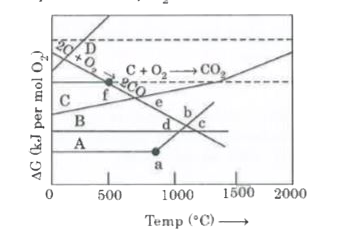The reduction potentials for the +2 cations, e.g.
A2++2e−→A,
of four metals decrease in the order A, B,C,D, which Statements is/are true?
(P) A reduces B2+ oxidizes C
(Q) B2+ oxidizes C
(R ) B oxides D
Q only
R only
P and Q only
P and R only
The correct Answer is:A
Step by step video, text & image solution for The reduction potentials for the +2 cations, e.g. A^(2+) + 2e^(-) rightarrow A, of four metals decrease in the order A, B,C,D, which Statements is/are true? (P) A reduces B^(2+) oxidizes C (Q) B^(2+) oxidizes C (R ) B oxides D by Chemistry experts to help you in doubts & scoring excellent marks in Class 12 exams.
Topper's Solved these Questions
- BOOK - GRB PUBLICATIONCHAPTER - ELECTROCHEMISTYEXERCISE - Latimer Diagram, concentration cells117videos
ELECTROCHEMISTY
- BOOK - GRB PUBLICATIONCHAPTER - ELECTROCHEMISTYEXERCISE - Batteries10videos
ELECTROCHEMISTY
- BOOK - GRB PUBLICATIONCHAPTER - ELECTROCHEMISTYEXERCISE - Subjective type39videos
ELECTROCHEMISTY
- BOOK - GRB PUBLICATIONCHAPTER - D-BLOCK ELEMENTSEXERCISE - Subjective Type18videos
D-BLOCK ELEMENTS
- BOOK - GRB PUBLICATIONCHAPTER - ENVIRONMENTAL CHEMISTRY EXERCISE - Straight objective type40videos
ENVIRONMENTAL CHEMISTRY
Similar Questions
Knowledge Check
- Question 1 - Select One
The standard reduction potential for half reactions for four different elements. A,B,C and D are:
(i) A2+2e−→2A−,E∘=+2.85V
(ii) B2+2e−→2B−,E∘=+1.36V
(iii) C2+2e−→2C−,E∘=+1.06V
(iv) D2+2e−→2D−,E∘=+0.53V
The strongest oxidising reducing agents smong these :AWould be A and D respectivelyBWould be D and A respectivelyCWould be B and C respectivelyDCannot be ascertained from the given data as the species being subjected to ioxidation or reduction have not been indicated - Question 2 - Select One
If a,b,c are in A.P. b, c,d are in G.P. and c,d,e are in H.P., then which one of the following is true :
A2c=a+eBae=c2Cc=2ae/a+eDab=de - Question 3 - Select One
If a = NO2,b=K2O,c=ZnO. These oxides in the decreasing order of basic nature will be:
Aa>b>cBb>c>aCc>b>aDa>c>b
A part of Ellingham diagram for some metal oxides (Based upon 1 mole of O2) and carbon is shown.

In figure A,B,C and D represent curves for metal oxides and a,b,c,d ,e and f are temperatures. Answer the following :
(i) Will B oxide reduce metal oxide of A or C or both ?
(ii) Which metal can be reduced thermally ?
(iii) Will oxide of B be reduced by coke above temperature c or below temperature c ?
(iv) Will the formation of CO or CO2 be preferred above temperature f ?
(v) What does temperature 'a' represent ?View SolutionIf A, B, C, D are numbers in increasing order and D, B E are numbers in decreasing order , then which one of the following sequences need neither be in a decreasing nor in an increasing order? E, C, D (b) E, B , C (c) D, B, A (d) A, E ,C
View SolutionThere are 3 unknown metals-A ,B and C,C displaces B from its oxide while with oxide of A, there is no reaction. Give the reactivity order of A, B and C.
View SolutionThe correct order of following 3d metal oxides, according to their oxidation numbers is :
(a)CrO3,(b)Fe2O3,(c)MnO2,(d)V2O5,(e)Cu2OView SolutionIf ab=cd=ef=4, then
m2a+n2c+p2em2b+n2d+p2f=?View Solution

